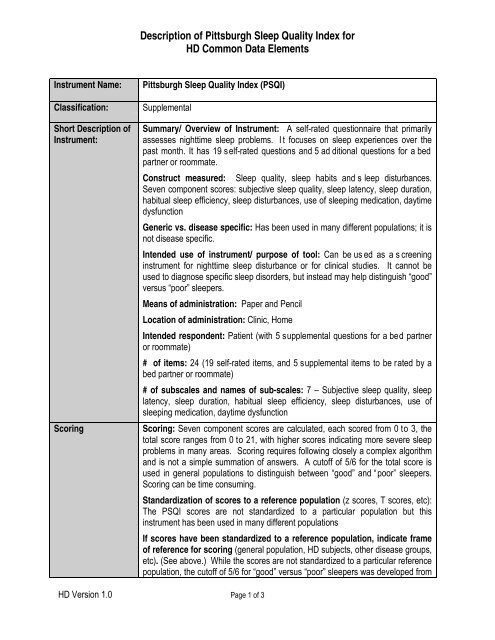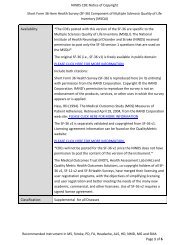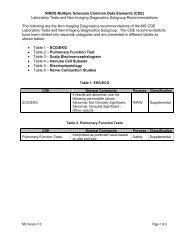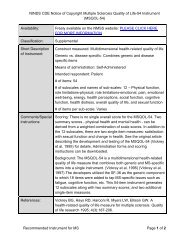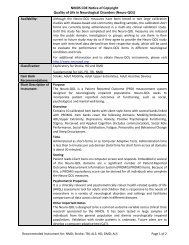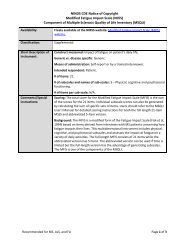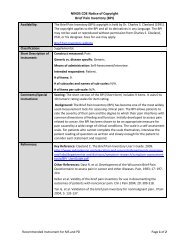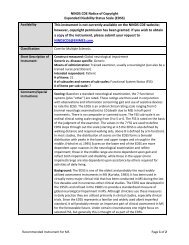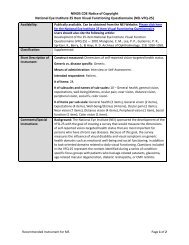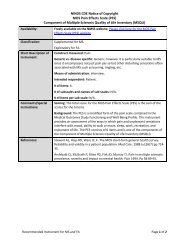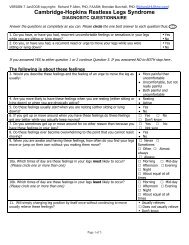NINDS CDE Huntington's Disease Behavioral Psychology Subgroup ...
NINDS CDE Huntington's Disease Behavioral Psychology Subgroup ...
NINDS CDE Huntington's Disease Behavioral Psychology Subgroup ...
You also want an ePaper? Increase the reach of your titles
YUMPU automatically turns print PDFs into web optimized ePapers that Google loves.
Description of Pittsburgh Sleep Quality Index forHD Common Data ElementsInstrument Name:Classification:Short Description ofInstrument:ScoringPittsburgh Sleep Quality Index (PSQI)SupplementalSummary/ Overview of Instrument: A self-rated questionnaire that primarilyassesses nighttime sleep problems. I t focuses on sleep experiences over thepast month. It has 19 s elf-rated questions and 5 ad ditional questions for a bedpartner or roommate.Construct measured: Sleep quality, sleep habits and s leep disturbances.Seven component scores: subjective sleep quality, sleep latency, sleep duration,habitual sleep efficiency, sleep disturbances, use of sleeping medication, daytimedysfunctionGeneric vs. disease specific: Has been used in many different populations; it isnot disease specific.Intended use of instrument/ purpose of tool: Can be us ed as a s creeninginstrument for nighttime sleep disturbance or for clinical studies. It cannot beused to diagnose specific sleep disorders, but instead may help distinguish “good”versus “poor” sleepers.Means of administration: Paper and PencilLocation of administration: Clinic, HomeIntended respondent: Patient (with 5 supplemental questions for a bed partneror roommate)# of items: 24 (19 self-rated items, and 5 supplemental items to be rated by abed partner or roommate)# of subscales and names of sub-scales: 7 – Subjective sleep quality, sleeplatency, sleep duration, habitual sleep efficiency, sleep disturbances, use ofsleeping medication, daytime dysfunctionScoring: Seven component scores are calculated, each scored from 0 to 3, thetotal score ranges from 0 to 21, with higher scores indicating more severe sleepproblems in many areas. Scoring requires following closely a complex algorithmand is not a simple summation of answers. A cutoff of 5/6 for the total score isused in general populations to distinguish between “good” and “ poor” sleepers.Scoring can be time consuming.Standardization of scores to a reference population (z scores, T scores, etc):The PSQI scores are not standardized to a particular population but thisinstrument has been used in many different populationsIf scores have been standardized to a reference population, indicate frameof reference for scoring (general population, HD subjects, other disease groups,etc). (See above.) While the scores are not standardized to a particular referencepopulation, the cutoff of 5/6 for “good” versus “poor” sleepers was developed fromHD Version 1.0 Page 1 of 3


